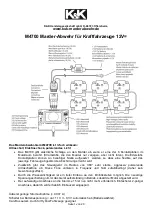
Traction
The traction grades, from highest to lowest, are
AA, A, B, and C.
Those grades represent the tire's ability to stop
on wet pavement as measured under controlled
conditions on specified government test surfa‐
ces of asphalt and concrete. A tire marked C may
have poor traction performance.
The traction grade assigned to this tire is based
on straight-ahead braking traction tests, and
does not include acceleration, cornering, hydro‐
planing, or peak traction characteristics.
Temperature
The temperature grades are A, the highest, B,
and C, representing the tire's resistance to the
generation of heat and its ability to dissipate heat
when tested under controlled conditions on a
specified indoor laboratory test wheel. Sustained
high temperature can cause the material of the
tire to degenerate and reduce tire life, and exces‐
sive temperature can lead to sudden tire failure.
The grade C corresponds to a level of perform‐
ance which all passenger car tires must meet un‐
der the Federal Motor Vehicle Safety Standard
No. 109. Grades Band A represent higher levels
of performance on the laboratory test wheel than
the minimum required by law.
Warning
The temperature grade for this tire is estab‐
lished for a tire that is properly inflated and not
overloaded. Excessive speed, underinflation, or
excessive loading, either separately or in com‐
bination, can cause heat buildup and possible
tire failure.
RSC – Run-flat tires
Run-flat tires, refer to page
, are labeled with
a circular symbol containing the letters RSC
marked on the sidewall.
M+S
Winter and all-season tires with better cold
weather performance than summer tires.
Tire tread
Summer tires
Do not drive with a tire tread of less than
0.12 in/3 mm, otherwise there is an increased
risk of hydroplaning.
Winter tires
Do not drive with a tire tread of less than
0.16 in/4 mm, as such tires are less suitable for
winter operation.
Minimum tread depth
Wear indicators are distributed around the tire's
circumference and have the legally required min‐
imum height of 0.063 inches/1.6 mm.
The positions of the wear indicators are marked
on the tire sidewall with TWI, Tread Wear Indica‐
tor.
Tire damage
General information
Inspect your tires regularly for damage, foreign
objects lodged in the tread, and tread wear.
Driving over rough or damaged road surfaces, as
well as debris, curbs and other obstacles can
Seite 257
Wheels and tires
MOBILITY
257
Online Edition for Part no. 01402779113 - II/19
Summary of Contents for Z4
Page 2: ...Online Edition for Part no 01402779113 II 19 ...
Page 6: ...6 Online Edition for Part no 01402779113 II 19 ...
Page 7: ...NOTES Information 8 Owner s Manual media 16 7 Online Edition for Part no 01402779113 II 19 ...
Page 18: ...18 Online Edition for Part no 01402779113 II 19 ...
Page 34: ...34 Online Edition for Part no 01402779113 II 19 ...
Page 235: ...Cargo area CONTROLS 235 Online Edition for Part no 01402779113 II 19 ...
Page 236: ...236 Online Edition for Part no 01402779113 II 19 ...
Page 248: ...248 Online Edition for Part no 01402779113 II 19 ...
Page 307: ...Care MOBILITY 307 Online Edition for Part no 01402779113 II 19 ...
Page 308: ...308 Online Edition for Part no 01402779113 II 19 ...
Page 313: ...Appendix REFERENCE 313 Online Edition for Part no 01402779113 II 19 ...
Page 327: ... BL2779113002 01402779113 ue ...
Page 328: ......
















































